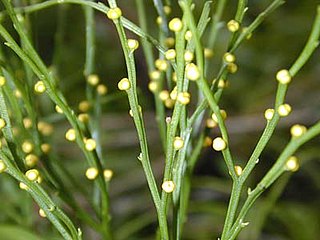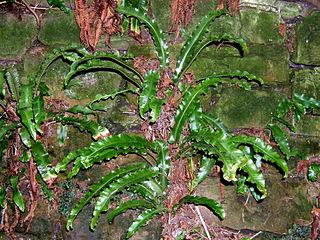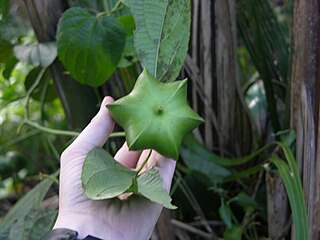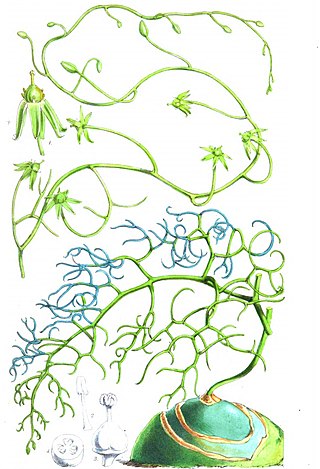
Brazil, officially the Federative Republic of Brazil, is the largest and easternmost country in South America and Latin America. It is the world's fifth-largest country by area and the seventh most populous. Its capital is Brasília, and its most populous city is São Paulo. Brazil is a federation composed of 26 states and a Federal District. It is the only country in the Americas where Portuguese is an official language. Brazil is among the world's most multicultural and ethnically diverse nations, due to over a century of mass immigration from around the world.

The ferns are a group of vascular plants that reproduce via spores and have neither seeds nor flowers. They differ from mosses by being vascular, i.e., having specialized tissues that conduct water and nutrients, and in having life cycles in which the branched sporophyte is the dominant phase.

Herbaceous plants are vascular plants that have no persistent woody stems above ground. This broad category of plants includes many perennials, and nearly all annuals and biennials.

Dicksonia is a genus of tree ferns in the order Cyatheales. It is regarded as related to Cyathea, but is considered to retain more primitive traits, dating back at least to the Jurassic and Cretaceous periods. The fossil record includes stems, pinnules, and spores.

Sphaeropteris cooperi, synonym Cyathea cooperi, also known as lacy tree fern, scaly tree fern, or Cooper's tree fern, is a tree fern native to Australia, in New South Wales and Queensland.

Blechnaceae is a family of ferns in the order Polypodiales, with a cosmopolitan distribution. Its status as a family and the number of genera included have both varied considerably. In the Pteridophyte Phylogeny Group classification of 2016, the family has 24 genera, and excludes genera placed in the separate family Onocleaceae. The family is divided into three subfamilies, including Blechnoideae s.s. Alternatively, the entire family may be treated as the subfamily Blechnoideae s.l. of a very broadly defined family Aspleniaceae, and include genera others place in Onocleaceae.

Asplenium scolopendrium, commonly known as the hart's-tongue fern, is an evergreen fern in the family Aspleniaceae native to the Northern Hemisphere.

Osmunda regalis, or royal fern, is a species of deciduous fern, native to Europe, Africa and Asia, growing in woodland bogs and on the banks of streams. The species is sometimes known as flowering fern due to the appearance of its fertile fronds.

Azolla filiculoides is a species of aquatic fern. It is native to warm temperate and tropical regions of the Americas, and has been introduced to Europe, North and sub-Saharan Africa, China, Japan, New Zealand, Australia, the Caribbean and Hawaii.

Plukenetia volubilis, commonly known as sacha inchi, sacha peanut, mountain peanut, Inca nut or Inca-peanut, is a perennial plant in the family Euphorbiaceae, having small trichomes on its leaves. It is native to much of tropical South America, as well as some of the Windward Islands in the Caribbean. It is cultivated commercially in South East Asia, most notably in Thailand. Although its raw seeds and leaves contain toxins, these components are safe for consumption after roasting.

Salpichlaena is a genus containing two species of fern in the family Blechnaceae. Species of the genus are native to Central and South America. These ferns have climbing leaves with a rachis that twines around tree branches and other supports.

Rumohra adiantiformis, the leather fern or leatherleaf fern, is a species of fern in the wood fern family Dryopteridaceae. It has a wide distribution, mainly in the tropical Southern Hemisphere.

Bowiea, commonly known as climbing-onion, is a genus of bulbous, perennial, succulent plants which thrive in dry and desert regions of eastern and southern Africa, ranging from Uganda to South Africa. It is native to a region stretching from Kenya to Cape Province. It is the 14th most commonly sold medicinal plant in South Africa, used to treat various health conditions. Due to massive harvesting, populations of this plant have been significantly reduced. Because of its high content of potent cardiac glycosides, it is highly poisonous, and deaths of humans and other animals after ingestion are attributed to cardiac arrest. Due to its unique appearance, it is cultivated as a houseplant.

Lygodium japonicum is a species of fern that is known by the common names vine-like fern and Japanese climbing fern. It is native to eastern Asia, including Taiwan, Japan, Korea, southeastern Asia, and India, and eastern Australia. The fern is present in the southeastern United States and Puerto Rico as an introduced species.

George Edward Post (1838–1909) was an American surgeon, academic and botanist.

Petrea volubilis, commonly known as purple wreath, queen's wreath or sandpaper vine, is an evergreen flowering vine in the family Verbenaceae, native to tropical America, that is valued especially for its display of violet flowers.
Tryonia is a genus of ferns in the subfamily Pteridoideae of the family Pteridaceae. Species are native to the east of Brazil and to Uruguay.

Hemionitis is a genus of ferns in the subfamily Cheilanthoideae of the family Pteridaceae. Its circumscription varies greatly in different systems of fern classification. In the Pteridophyte Phylogeny Group classification of 2016, it was one of more than 20 genera in the subfamily Cheilanthoideae, and was said to have five species. Other sources treat it as the only genus in the subfamily, and so accept about 450 species. With the restricted circumscription, species are native to tropical America.
Olfersia is a genus of ferns in the family Dryopteridaceae, subfamily Polybotryoideae, in the Pteridophyte Phylogeny Group classification of 2016. They are found in Mexico and parts of South America.

Moquilea tomentosa is a species of flowering plant in the family Chrysobalanaceae, native to most of Brazil. It is widely cultivated for its abundant fruit in South America and South Africa, and it is used as a street tree in Brazil and Colombia.


















